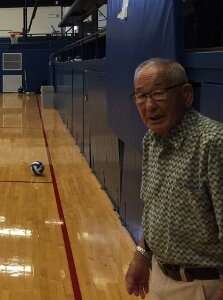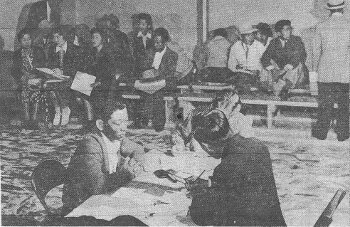“He put his head against my father’s shoulder and cried. He said, ‘Mr. Yamaichi, my boss told me that they were going to put all of you into camps.’”
By Will Kaku The 36th Annual San Jose Day of Remembrance will take place on February 14, 2016, at a historically significant venue, Yoshihiro Uchida Hall at San Jose State University. The hall is the same location where Japanese Americans were processed before they were forcibly sent to detention centers at the end of May, 1942. The Day of Remembrance program will start at Morris Dailey Auditorium and the program will conclude with a solemn candlelight procession to Uchida Hall. Inside the Uchida Hall, JAMsj curator, Jimi Yamaichi, will recount what happened in the hall’s gymnasium 74 years ago and the tumultuous events that surrounded the forced removal of several thousand Japanese Americans in the San Jose area.Jimi recalled, “On Sunday night (the evening of the Pearl Harbor attack), we were visited by Ted Myers who was a buyer of our farm produce and a family friend. He said that he got a call from the main office in Los Angeles telling him to go down there for an urgent meeting.”On Wednesday afternoon, Myers came back to see the Yamaichi family. “I can still remember how his face looked,” Jimi remembered. “He put his head against my father’s shoulder and cried. He said, ‘Mr. Yamaichi, my boss told me that there were going to put all of you into camps.’”Jimi trusted Myers’ information in the context of the racially-charged times. “For many years, they tried to get us out of California. You have to understand that although Japanese only made up 2% of the population, we controlled a majority of the vegetable market. The Farm Bureau, the California State Grange, the American Legion, and the Sons and Daughters of the Golden West, were among many anti-Japanese groups and they were lobbying hard to get rid of us. This was their opportunity to finally break our backs and decimate the Japanese farmer.”A few months later, signs were posted on telephone poles that specified that all people of Japanese descent would be removed from the San Jose area by 12 p.m. on Saturday, May 30, 1942. Family representatives were told to report to the men’s gymnasium at San Jose State College (now renamed Yoshihiro Uchida Hall at San Jose State University). On May 23 and May 24, the gymnasium served as a registration center that processed 2,847 people of Japanese descent before they were incarcerated. Because Jimi’s father could not read or write English, Jimi represented his family.
The 36th Annual San Jose Day of Remembrance will take place on February 14, 2016, at a historically significant venue, Yoshihiro Uchida Hall at San Jose State University. The hall is the same location where Japanese Americans were processed before they were forcibly sent to detention centers at the end of May, 1942. The Day of Remembrance program will start at Morris Dailey Auditorium and the program will conclude with a solemn candlelight procession to Uchida Hall. Inside the Uchida Hall, JAMsj curator, Jimi Yamaichi, will recount what happened in the hall’s gymnasium 74 years ago and the tumultuous events that surrounded the forced removal of several thousand Japanese Americans in the San Jose area.Jimi recalled, “On Sunday night (the evening of the Pearl Harbor attack), we were visited by Ted Myers who was a buyer of our farm produce and a family friend. He said that he got a call from the main office in Los Angeles telling him to go down there for an urgent meeting.”On Wednesday afternoon, Myers came back to see the Yamaichi family. “I can still remember how his face looked,” Jimi remembered. “He put his head against my father’s shoulder and cried. He said, ‘Mr. Yamaichi, my boss told me that there were going to put all of you into camps.’”Jimi trusted Myers’ information in the context of the racially-charged times. “For many years, they tried to get us out of California. You have to understand that although Japanese only made up 2% of the population, we controlled a majority of the vegetable market. The Farm Bureau, the California State Grange, the American Legion, and the Sons and Daughters of the Golden West, were among many anti-Japanese groups and they were lobbying hard to get rid of us. This was their opportunity to finally break our backs and decimate the Japanese farmer.”A few months later, signs were posted on telephone poles that specified that all people of Japanese descent would be removed from the San Jose area by 12 p.m. on Saturday, May 30, 1942. Family representatives were told to report to the men’s gymnasium at San Jose State College (now renamed Yoshihiro Uchida Hall at San Jose State University). On May 23 and May 24, the gymnasium served as a registration center that processed 2,847 people of Japanese descent before they were incarcerated. Because Jimi’s father could not read or write English, Jimi represented his family. Many decisions had to be made in a short amount of time. “We sold our cars, tractors, and other major stuff at a big discount,” Jimi remembered. “We also looked at leasing our property. Our insurance agent said, ‘I’ll take care of it. I don’t need a Power of Attorney agreement. I’ll collect the rent and put it in the bank.” Jimi’s second cousin was not so lucky. “He gave the full Power of Attorney to a friend. He had 24 acres. When he came back, his friend said, ‘it is not your property; it’s mine.’”
Many decisions had to be made in a short amount of time. “We sold our cars, tractors, and other major stuff at a big discount,” Jimi remembered. “We also looked at leasing our property. Our insurance agent said, ‘I’ll take care of it. I don’t need a Power of Attorney agreement. I’ll collect the rent and put it in the bank.” Jimi’s second cousin was not so lucky. “He gave the full Power of Attorney to a friend. He had 24 acres. When he came back, his friend said, ‘it is not your property; it’s mine.’” On May 30, 1942, Jimi and his large family were driven by their insurance agent friend and a grammar school principle to the departure point near the railway station at San Pedro Street. Many of the San Jose residents were sent to the thoroughbred racetrack in Arcadia, California which was converted into the Santa Anita Assembly Center. That center filled up so they sent Jimi and his family to the detention center in Pomona, California. Jimi and his family would not return to the San Jose area until 1946.----------------------------------------------------------------------------------------------------------
On May 30, 1942, Jimi and his large family were driven by their insurance agent friend and a grammar school principle to the departure point near the railway station at San Pedro Street. Many of the San Jose residents were sent to the thoroughbred racetrack in Arcadia, California which was converted into the Santa Anita Assembly Center. That center filled up so they sent Jimi and his family to the detention center in Pomona, California. Jimi and his family would not return to the San Jose area until 1946.----------------------------------------------------------------------------------------------------------
36th Annual San Jose Day of RemembranceFebruary 14, 20165:30 p.m - 7:30 p.m.Morris Dailey AuditoriumSan Jose State University
 The 2016 San Jose Day of Remembrance commemorates the signing of Executive Order 9066, which led to the forced incarceration of 120,000 people of Japanese descent, two-thirds of whom were American citizens.The theme of the 2016 event is "Wartime Hysteria." In the Civil Liberties Act of 1988, the U.S government acknowledged that "a great injustice was done to both citizens and permanent resident aliens of Japanese ancestry" and that the acts were "motivated largely by racial prejudice, wartime hysteria, and a failure of political leadership." The 2016 Day of Remembrance theme warns against the rise of wartime hysteria, as well as racial and religious discrimination, in today's politically volatile, emotionally-charged environment as the nation confronts the issues of war, refugees, and terrorism.A featured speaker will be Jimi Yamaichi, a prominent leader in the San Jose Japantown community, who will recount his memories of being processed at the gymnasium and forcibly uprooted from his home during those traumatic days of 1942.
The 2016 San Jose Day of Remembrance commemorates the signing of Executive Order 9066, which led to the forced incarceration of 120,000 people of Japanese descent, two-thirds of whom were American citizens.The theme of the 2016 event is "Wartime Hysteria." In the Civil Liberties Act of 1988, the U.S government acknowledged that "a great injustice was done to both citizens and permanent resident aliens of Japanese ancestry" and that the acts were "motivated largely by racial prejudice, wartime hysteria, and a failure of political leadership." The 2016 Day of Remembrance theme warns against the rise of wartime hysteria, as well as racial and religious discrimination, in today's politically volatile, emotionally-charged environment as the nation confronts the issues of war, refugees, and terrorism.A featured speaker will be Jimi Yamaichi, a prominent leader in the San Jose Japantown community, who will recount his memories of being processed at the gymnasium and forcibly uprooted from his home during those traumatic days of 1942. Other speakers include Congressman Mike Honda, who was incarcerated at the Amache internment camp, Japanese American Museum of San Jose president and SJSU alumnus, Aggie Idemoto, poet Ann Muto, and other members from the community. The annual event will also include a performance by the internationally acclaimed, San Jose Taiko, and a special candlelight procession to Yoshihiro Uchida Hall, the same location where Japanese Americans were processed before they were forcibly removed from the San Jose area.The event will be held on February 14, 2016, from 5:30-7:30 p.m, in the Morris Dailey Auditorium. A post-event reception will take place in nearby Uchida Hall. The event is free and open to the public (campus parking garages charge a fee).For more information, email info@sjnoc.org.Website: www.sjnoc.orgMap to Morris Dailey Auditorium at San Jose State University.
Other speakers include Congressman Mike Honda, who was incarcerated at the Amache internment camp, Japanese American Museum of San Jose president and SJSU alumnus, Aggie Idemoto, poet Ann Muto, and other members from the community. The annual event will also include a performance by the internationally acclaimed, San Jose Taiko, and a special candlelight procession to Yoshihiro Uchida Hall, the same location where Japanese Americans were processed before they were forcibly removed from the San Jose area.The event will be held on February 14, 2016, from 5:30-7:30 p.m, in the Morris Dailey Auditorium. A post-event reception will take place in nearby Uchida Hall. The event is free and open to the public (campus parking garages charge a fee).For more information, email info@sjnoc.org.Website: www.sjnoc.orgMap to Morris Dailey Auditorium at San Jose State University.
